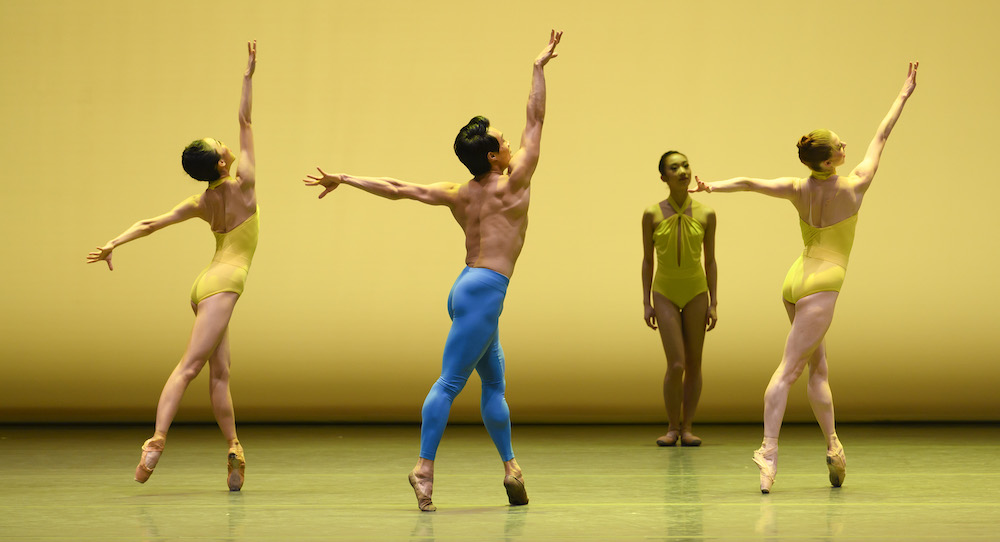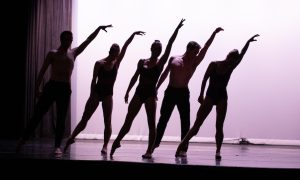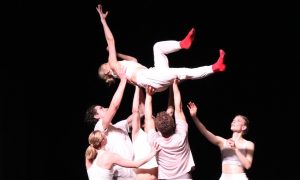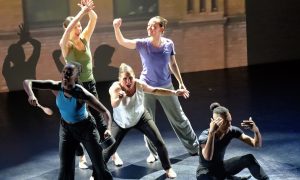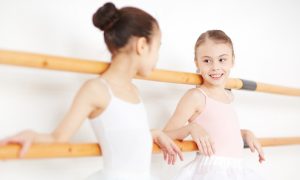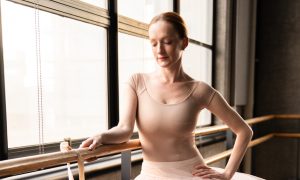Boston Opera House, Boston, MA.
February 25, 2024.
World-building is commonly discussed in the art forms of literature, film and television – yet are there worlds of their own in concert dance as well? This critic defies anyone to say that there aren’t. None of that is a revolutionary idea, yet occasionally works of dance art demonstrate just how much is possible within world-building for dance. Such works filled Boston Ballet’s Winter Experience.
Scenic design, lighting and costuming design did heavy lifting to shape and contour the worlds staking their claim to the stage. Yet, serving their purpose to the fullest, those design elements framed and highlighted the center of it all: the movement – sometimes soothing, sometimes bracing, always captivating. With the program presenting two contemporary works and a classical ballet, Winter Experience also underscored that all of these principles can hold true for classical and contemporary work alike.
Lights rose on the world premiere of Helen Pickett’s To Be One, on light blue walls (concept and creation also by Pickett, lighting design by Brandon Stirling Baker) and an ethereal score (by Mikael Karlsson). Three walls of scrims – as high as the wings – formed the stage’s perimeter, with the proscenium forming the fourth wall (we in the audience at the “fourth wall,” indeed).
Dancers in white (costume design by Sara Marhamo Kirk) moved through dynamic, exciting vocabulary. Spacious long lines moved along circular joint paths. Spines curved and straightened, executing a sort of contemporary ballet “fall and recover.” This movement was seemingly the fruits of various choreographic tools and structures, shaken up and then settling into place to cohesively mix and meld.
The dancers’ rock-solid command of the movement, along with their stellar musicality, made of all that highly visceral – tingles up the spine and all. They danced with a kind of confident cool, a suave strength. At times the pace and intensity felt driving and relentless; I’m always one to advocate for moments of softening, away from such high speed and power.
Yet with slower, gentler sections later on, it hit me that the work was only extremely musical. As the score crescendo-ed and decrescendo-ed, so did the movement – and beautifully so. With sections shifting to something more allegro and then adagio, in turn the walls also changed color: from a bright orange to a mellow lavender. In each mode – at each intensity – a world of color, sound, and movement invited us to come savor its fruits.
Pickett’s Petal (2008) followed – a work of a similarly riveting world of its own filling the stage – the whole house, really, with its waves of color and sound vibrating (I bet) to the last balcony seat. One could argue that it was too similar: three walls of backlit scrim, fairly minimalistic costumes in solid colors, highly musical movement vocabulary in the same stylistic vein.
I wondered about Pickett’s longer-term process here; with one work a world premiere and one from sixteen years ago, were these works variations on a theme? Were they unrelated, and just how she’s been creatively drawn? What was the programming rationale for presenting two works back-to-back of such similar aesthetic and concept? I had questions.
Yet, looking from the lens of world-building, one could imagine that we were perhaps traveling to a new corner of this onstage world. In any case, the movement was so beautiful and the aesthetic so satisfying that those questions didn’t distract me all too much.
The ensemble brought the same strong suave to this piece. Three ballerinas, facing upstage, tapped a pointe shoe behind them and slyly looked to the audience – their timing and musicality impeccable. A horizontal line of dancers across the stage reached one arm up, stepping and rolling hips in the same direction. They didn’t force a thing, and why would they? Their movement raw material and artistry toolbox were more than enough to enthrall.
In particular, the movement had a lovely verticality, but also rootedness right into the stage – like flowers, immovable yet always rising towards the sun. With a unique brightness and sparkle, the work felt like a visit from spring. Something fresh and lively was in the air, just like when buds start to pop and birds begin singing again.
That felt like an interesting choice for a winter program – and a very welcome one, really, with us in the throes of (it feels like) endless New England winter. The last section of the piece even felt like the first fiery days of summer, the ensemble dancing with a new speed and abandon. Ah, it’s coming indeed – not soon enough, but warmer days are ahead.
The second act brought Raymonda, reimagined by Mikko Nissinen and with additional choreography from Florence Clerc and Alla Nikitina. This was a quintessentially classical ballet in quite modern packaging, two approaches coming together to realize something supremely satisfying.
Old movie-style, a screen within a projected picture frame introduced the ballet. The picture frame theme continued when that scrim rose, with half of a white picture frame over and around one half of the stage space (scenic and costume design by Robert Perdziola). Just a few flowers and ribbons adorned the frame. That was emblematic of the larger world at hand: classic, elegant, minimalistic. Opulence wasn’t the name of the game – refinement was.
Lighting (by Brandon Stirling Baker) was soft and just a touch ethereal, the costumes with lovely touches of dainty adornment. Movement was just as polished and elegant. In both performance and choreography, characterization and verisimilitude reigned supreme over technical feats (though there were those to enjoy, as well). Less was very much more in this land of royalty, court politics, and dreams of true love coming true.
Lia Cirio danced Raymonda, bringing her signature dazzling artistry to bear – with a feather light and wispy quality, not to mention plain exquisite musicality. The score swelled in larger ensemble sections, the royal court of this world reveling in the sensory feast at hand. We in the audience were welcome to feast as well.
Section II, “Raymonda’s Salon,” brought something more somber and more introspective. Movement eased, matching the longer, mellower notes of the score (from Alexander Glazunov, adapted by Mischa Santora). A motif evolved of arms rising into a delicate shape and spines then melting. This vocabulary embodied Raymonda’s passion, pathos, and innocence.
Section III brought “The Vision”: with a ghostly Fairy Godmother figure (La Dame Blanche, performed by Maria Rubin) pulling magical strings (one could imagine) and Raymonda witnessing her Prince Charming. Yue Shi danced her prince, Jean de Brienne, with equal parts brio and sensitivity. Their pas de deux oozed with both sweetness and technical rigor. Sunset reds, oranges, and pinks in the backdrop deepened the romance at hand. As another rather modern – and compelling – aesthetic choice, the scene ended with them center stage, in silhouette. That added mystery to their close embrace.
The “La Festival des Noces, the Wedding Celebration” of Section IV was a celebration indeed, offering a long string of solos, duets, trios, and a quartet. The aesthetic feast at hand continued, and a feast of movement qualities joined in: spritely and effervescent, full of raw power, and everything in between.
The whole court was there to celebrate, with us in the audience able to witness the individuality of each who danced. After an explosion of energy all across the stage, they ended all together in tableau. The silhouette returned, the elegant design choices continuing to the very end.
This was a world with its very own meeting of the classic and contemporary, one that I felt blessed to visit for all too short a time. Helen Pickett’s works brought me into a similarly unparalleled world, one of bursting color and vitality. This (real) world of ours can feel overwhelming, and we have new worlds like these to visit – where we can restore and revitalize. Thank you to Boston Ballet for welcoming us in!
By Kathryn Boland of Dance Informa.


